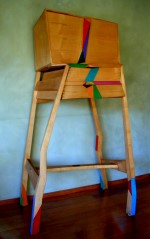SYNOPSIS
Called by Wired "an icon of 3D Animation", Brad has been an innovator in computer
animation in the entertainment industry since 1982, particularly in the areas of
realtime characters, ride films, and the Web.
Since 2000, he has concentrated on work at the intersection of media, technology,
finance, and social change. In addition to his current role as co-founder and CTO of the
Interra Project, that work
has included consultancy on digital media in international development, development of
web commerce and financial systems, and pro-bono work on social change through
alternative financing strategies and "disruptive" information technologies.
Prior to his computer career, he studied sculpture and architecture at Princeton
University, earned a BA in Mathematics from UC San Diego, and spent five years building
custom furniture .
SYNOPSIS
In 2000, Wired called Brad "an
icon in the world of 3D animation," and it's been all downhill since then. He has been building ambitious software systems for 45 years. In the last millennium, it was mainly around digital cartography and high-end computer animation.
This millennium, it has been social software.
In 2005, he conceived Smartocracy (LANL whitepaper) the first public demonstration of what is now called liquid democracy, five years before that term was coined.
"Societal-scale decision-making using trust networks" has been his hammer ever since.
From 2009 to 2017, Brad was co-founder and CEO of Sociative, best-of-breed in social news using the Smartocracy algorithm. Sociative was sold to EdCast in 2017, where Brad was a chief technology
architect.
When EdCast was bought by Cornerstone
, he refocused on the emergent coordination applications, building core infrastructure of growing and exploiting networks of trust and respect, under the rubric of networked adaptive organisms. See NooNAO.
In more detail:
He is a respected pioneer of computer animation,
particularly in the areas of realtime characters, ride films, and the Web. He founded
and/or managed several ground-breaking animation studios including Protozoa, Colossal Pictures
Digital Media, deGraf/Wahrman, and Digital Productions.
Since 2000, he has concentrated on work at the intersection of media, technology,
finance, and social change. Before Sociative, he was co-founder and CTO of the Interra Project, that work
has included a variety of consultancy roles focused on next-generation digital media
technology, particularly lately in international development work with the World Bank's International Finance
Corporation and the US Agency for
International Development.
Other recent roles include executive producer of Youthgive, executive director of the Internet Bookmobile project
, co-director for Moving
Images at the Internet Archive, and senior analyst for Jon Peddie Research.
In his copious spare time, Brad also develops web-based social applications, most
notably Books We Like and Smartocracy .
Brad began his career in 1979 as a Fortran programmer for Science Applications
International (SAIC), engineering interactive training systems and digital mapping
applications for the US Army National Training Center in Fort Irwin, CA.
In 1982, he joined Digital Productions in Los Angeles, as Head of Technical Direction,
and oversaw production there on numerous groundbreaking feature film, ride-film, and
commercial projects.
He co-founded deGraf/Wahrman in 1987, where, inspired by a collaboration with Jim
Henson, he created the first live computer-generated character, and produced several
"firsts" in computer-generated ridefilms.
In 1992, he joined Colossal Pictures, the leading San Francisco animation company for
two decades, to start up a digital media division, to replace their previous
co-production relationship with Pixar, which had recently shifted over to producing
features with Disney. He grew the department to 30+ people, producing all forms of
digital media, including Robocop the Ride in Imax for Iwerks; two CD-ROMs for
Broderbund; Cartoon Network's launch character; numerous commercials and music videos;
and several early interactive television interface designs including the Full Service
Network for TimeWarner/SGI, and First Person, the precursor to Java.
In late 1994, he and his partners spun off to create Protozoa (aka Dotcomix) for which he served as Chairman, CEO, and Chief
Creative Officer. In those roles, he oversaw the creation of over 24 hours of televised
animation and a year of daily web cartoons, and raised over $13M.
Prior to his computer career, he studied sculpture and architecture at Princeton, earned
a BA in Mathematics from UC San Diego, and spent five years building custom
furniture.
Credits include:
- Duke2000.com, a campaign with Garry Trudeau to get his
Ambassador Duke character elected president;
- Moxy, emcee for the Cartoon Network, the first virtual character for television;
- Floops, the first Web episodic cartoon;
- Peter Gabriel's Grammy award- winning video, Steam;
- "The Funtastic World of Hanna-Barbera", the first computer-generated ride film;
- feature films "The Last Starfighter", "2010", "Jetsons: the Movie", "Robocop 2",
- and numerous television shows.
PAST WORK
Social Finance
INTERRA
July 2006 to the present
- Co-founder - Co-founded, with the founders of
Odwalla and Visa among others, a universal, card-based loyalty/affinity
system that creates an economic ecosystem aligning local merchants, conscious
consumers, and the causes they care about. First deployment is Boston Community
Change for the city of Boston, with Puget Sound, Cleveland, and San
Francisco Bay Area launching October 2007 through March 2008.
- Chief Technical Officer - Provide technical vision, oversight, and
leadership over all aspects of Interra's work, including internal development,
subcontracting, and partnerships.
YOUTHGIVE - school-based social network and financial system for
study of philanthropy
June - December, 2006
- System Design and Executive Production - Developed a system and
website for Youthgive that
combines a social network of youth, parents, and teachers; curricula around the
study of local and international non-profits and philanthropy in general; an online
"catalogue of philanthropy" co-created by the students; a print version for holiday
season distribution in local communities; and "giving accounts" that act as
"allowances for giving", filled by parents and others, and donated by the users to
their favorite causes.
International Development
World Bank's International Finance Corporation - Industry
Specialist in Digital Media
January 2000 to the present
-
Provide expertise and assistance in due diligence for digital media investments
under consideration by IFC's Information Technology group.
- Projects in China, Vietnam, India, and Jordan so far. Involve early-stage project
review, multi-week on-site visits, financial and other due diligence, and final
report including yes/no investment recommendation. Coincidentally or not,
recommendations have been followed.
- At the request of IFC, hired as board member and US director of business development
for Glass Egg , an IFC portfolio company in
Saigon, Vietnam.
US Agency for International Development - Digital Media Strategy
for SE Europe
October 2004 to the present
- Macedonia - Hired by USAID's Macedonian Competitiveness Activity in
Skopje, Macedonia for several projects, ranging from business strategy for specific
companies to industry-wide vision and strategy for their digital media sector.
Recommendations have resulted in major investments of resources, including a
nation-wide training program for 3D animation, 3D @ E-Schools, and formation of a digital media trade
organization, among others.
- Europe and Eurasia Bureau, Regional Competitiveness Intiative -
Macedonian work expanded to the development of a digital media strategy for
southeastern Europe, focusing on Romania, Bulgaria, and former Yugoslavia. The
project included a thorough exploration of existing digital media capacity, the
venture capital and enterprise fund industries needed to finance it, and the
opportunities for deveopment of "digital media parks" networked throughout the
region. Here is the final
report.
-
Digital Media Park in Skopje, Macedonia - Wrote successful proposal
for a USAID Global
Development Alliance for a "digital media park" in the capital city,
recently funded for $500,000. Consulted on acquisition of a de-commissioned military
building from the Ministry of Defense.
- On-going advisory role with one Macedonian studio, FX3X, successfully getting them work on Martin
Scorcese's Aviator and major contributions to PBS Kids' new series, It's a Big Big World.
Internet Systems and Social Change
Internet Archive
March 2002 - July 2005
- Directed the Moving Image archive at the Internet
Archive for most of 2002.
- Secured a grant from SIGGRAPH Special
Projects to create a sub-collection of the Moving Image archive showcasing
the best of computer graphics.
- Served as Executive Director for the Internet Bookmobile
project from late 2002 through late 2004. Created a standalone organization, Anywhere Books, fiscally sponsored by
the Rudolf Steiner Foundation, to support the project.
- Secured a $150,000 grant from the World Bank's Information for Development Program for an
Internet Bookmobile in Uganda, and successfully managed the project on time and
budget.
Media Venture Collective - Founder and Executive Director
- Media Venture Collective was
conceived as a "third way" between grants and venture funding, to provide startup
and working capital for public-benefit enterprises that have the potential to thrive
financially.
- It is a fund of the Rudolf
Steiner Foundation, in partnership with a super-group of activist
organizations, focused on aggregating tax-deductible donations and grants, small and
large, into "program-related investments" in high-impact, public-interest
media enterprises.
- MVC has raised over $260,000, with very little overhead, of such projects as the
Internet Bookmobile, Critical Mass
Radio, Books We Like, YouthGive, Ethical Markets, and Smartocracy.
- Books We Like - Conceived,
designed, and raised $30,000 (from Alternet
and Wallace Global Fund) for this innovative,
non-profit service for activist e-commerce and collective intelligence. BWL is a
peer-to-peer recommendation system for book (and music and film) lovers, that
generates revenues from commissions on the online purchases of its users and passes
those on to a partner network of social-change non-profits.
- Smartocracy - Conceived,
designed, and raised $25,000 (from Threshold Foundation and Wallace Global Fund) for this experiment in
"augmented democracy". It uses a simple social network as a tool for making
collective decisions meritocratically. Initial application is to enlist a network of
1000+ independent media influencers in deciding how to re-grant some of the funding
for media reform projects. (view the original
proposal).
Social Networking Tools
- Link Tank - Conceived, convened, and led the Link Tank, an ad-hoc
group of brilliant, multi-disciplinary thinkers focused on the use of new
information technologies in support of large-scale "eco-social" change.
- Among other outcomes, Link Tank raised grant funding for and commissioned a white
paper called The Augmented Social
Network (see Acknowledgements) which was widely regarded as a
significant step forward in envisioning the use of social networks for public
benefit.
- In 2002, Link Tank commissioned a very early social networking system that
pre-cursed the emergence of such systems as LinkedIn, Friendster, MySpace, etc.
- Spinoff projects include Media Venture Collective (see below), and the Interra Project.
Miscellaneous
-
The Media
Consortium - member, and recognized tech expert, of a network
of progressive, independent media producers and distributors, including Mother
Jones, Air America, Alternet, Ms. Magazine,
Link TV, Grist, and many more.
-
San Francisco State University's Institute for Next Generation
Internet - help develop strategies for international collaboration,
distance learning, new distribution technologies etc.
- Mayor Gavin Newsom's Digital Media Advisory Council - helping
develop a unifying vision and strategy for the city's digital media initiatives.
- Jon Peddie Research - Senior Analyst focusing on
entertainment issues such as game development, 3D animation, etc.
ADVANCED COMPUTER ANIMATION
1983-2000
Overall credits include:
- Duke2000, a campaign with Garry Trudeau to get
his Ambassador Duke character elected president, including a full
hour on Larry King Live and a debate with
Bush and Gore (2000);
- Moxy, emcee for the Cartoon Network, the first virtual character
for television (1995);
- Mike the Talking Head, the first live performance of a virtual
character, at the SIGGRAPH Electronic Theatre (1988);
- collaboration with Jim Henson on the first digital puppet, marrying Henson's "Waldo"
controls normally used for physical puppets to a real-time computer character
(1985);
- Floops, the first Web episodic cartoon (1997);
- Peter Gabriel's Grammy award- winning video, Steam (1993);
- "The Funtastic World of Hanna-Barbera", the first
computer-generated ride film (1989);
- "Journey to the Fourth Dimension", the first sterescopic ride film
(1990);
- "Robocop - the Ride", Imax ride film for Iwerks Entertainment;
- feature films "The Last Starfighter" (1984),
"2010" (1985), "Jetsons: the Movie (1989)",
"Robocop 2 (1988)";
- "Virtual
Bill" Clinton, on MTV (1998-99);
- "Squeezils", flying squirrel simulator game for
Inscape (1994-95);
- and numerous television shows on PBS, Disney, TechTV, etc.
Protozoa/Dotcomix
November 1994 - November 2000
- Founder and CEO - Raised startup funding of $2M from Motorola New
Ventures to spin off the Digital Media division of Colossal Pictures (see below).
- Protozoa was a leading developer and user of real-time 3D character animation
systems. It produced over 24 hours of televised animation for MTV, Disney, ZDTV (now
TechTV), and numerous others. Its $80,000 flagship product Alive had
licensees in Germany, Holland, South Africa, Japan, and the United States, including
MTV and ZDTV.
- The company's launch coincided with the rise of the Internet, and real-time
character made a compelling web opportunity, leading to a subsidiary company,
Dotcomix, which produced more original animation for the web than any other company,
approximately 1 minute per day for eighteen months.
- Additional investors including Intel, Hearst Communications, Rogers Communications,
Allegis Capital, and others.
- The company was sold in late 2000 to Dreamtime, another Internet startup that
promptly went out of business.
Colossal Pictures
September 1992 - November 1994
- Board member and Director of Digital Media - joined Colossal, the
leading San Francisco animation company for two decades, to start up a digital media
division, to replace their previous co-production relationship with Pixar, which had
recently shifted over to producing features with Disney.
- grew the department to 30+ people, producing all forms of digital media, including:
- Cartoon Network's launch character Moxy;
- music video for Peter Gabriel's "Steam", which one the music video Grammy in
1993
- Robocop the Ride in Imax for Iwerks;
- two Living BookCD-ROMs for Broderbund;
- numerous commercials and music videos; and
- several early interactive television interface designs including the Full
Service Network for TimeWarner/SGI, and First Person, the precursor to Java
- spun off Protozoa in 1994.
deGraf Associates
January 1991 - September 1992
- Independent 3D software developer - developed a second-generation
real-time character animation system, Alive, based on lessons learned from
previous implementations with Henson and deGraf/Wahrman (see below)
- Licensed Alive to Walt Disney Imagineering
- Under contract with Silicon Graphics (SGI), prototyped an "Electric Atlas", a
precursor to Google Earth, that unfortunately required a $100,000 computer at the
time.
- consulted with Sony on the formation of Imageworks, its digital effects division,
and with Colossal Pictures
- Motion-capture for Blue-Sky Studio's "Spaceboy in Sky-high Scramble"
- Licensed Alive to Colossal Pictures as part of employment contract (see
above)
deGraf/Wahrman
Spring 1988 - Late 1990
- Co-founder, President, and Head of Production - designed and
developed Perform, the first real-time character animation system
- 1988 - "Mike the Talking Head", the first live performance of a computer character,
at the SIGGRAPH Electronic Theatre in 1988
- 1989 - Produced the villain character in "Robocop 2"
- 1990 - More than five minutes of animation in "Jetsons: the Movie" from
Hanna-Barbera
- 1990 - Produced three state-of-the-art ride films for Universal Studios Florida and
Landmark Entertainment, the first use of computer animation, and of stereoscopic
computer animation in theme parks
- 1989 - Digital puppets for "The Warrior Ant" at Brooklyn Academy of Music, for Lee
Breuer and Mabou Mines
- 1989 - Live performance opening the second TED Conference
Digital Productions
Spring 1983 - Late 1987
- Head of Technical Direction - managed a department of over 30
artists and technicians
- oversaw production of more than 20 minutes of finished animation for "The Last
Starfighter", using a Cray XMP supercomputer
- co-directed "Plan 3D from Outer Space", a stereoscopic expo film for Hitachi's
pavilion at Expo '85 in Tsukuba, Japan
- Animated the new AT&T "death star" logo, directed by its designer, the great Saul
Bass. That animation was in regular use for over ten years.
- Highlighted in US News and World Report in article on "Jobs of the Future".
Science Application Inc. (SAIC)
Spring 1979 - Spring 1983
- Graphics Programmer - engineered interactive training systems and
digital mapping applications for the US Army National Training Center in Fort Irwin,
CA, and produced graphics for the company's annual reports.
LOGOS and FURNITURE
Logo Design
designed numerous highly regarded logos

|

|

|

|

|
|
Protozoa
|
ROVR
|
Signal Hill
|
Anywhere Books
|
Bloobot
|
SKILLS
Business
- All aspects of jumpstarting, running, positioning adventurous ventures
- Business Plans
- Financial Models
- Financing and Fundraising
- Road Shows
- Vision and Leadership
- A great Rolodex
Technical
- somewhat over-the-hill former hotshot but acquisitive of new programming skills,
especially web-native
- Ruby, Python, PhP, Javascript, Java, Plone
- HTML, CSS
- JSON, XML, AJAX
- *SQL
- Salesforce.com and other CRM
EDUCATION
- 1971-72 - Princeton University undergraduate, concentrating on Architecture
- 1977-79 - Virginia Commonwealth University, Sculpture and Craft major
- 1979-81 - UC San Diego, Mathematics, BA
- fluent in French and Spanish
EXHIBITION
In progress, not complete.
- 1983 - SIGGRAPH Art Show, exhibition poster image
- 1985 - "Plan 3D from Outer Space", stereoscopic short film for Hitachi Pavilion,
Expo '85 in Tsukuba, Japan
- 1989 - Art Futura, "Paz", live host character
- 1989 - Ars Electronica, "Xen", 60-minute stereoscopic film directed by artist Tom
Shannon, performed with live concert by Jon Hassell
- 1989 - "The Funtastic World of Hanna-Barbera", first computer-generated ride film,
for Universal Studios Florida
- 1990 - "Journey to the Fourth Dimension", stereoscopic 70mm ride film for Landmark
Entertainment, Sanrio Puroland, Japan
- 1991 - "Journey to Inner Space", stereoscopic 70mm ride film for Landmark
Entertainment, Sanrio theme park, Oita, Japan
- 1992 - Spanish Pavilion at the World's Fair in Sevilla, Spain - virtual tour guide
"Roscoe"
- 1993 - "Robocop - the ride", Imax ride film for Iwerks Entertainment
- SIGGRAPH Electronic Theatre - annual showcase of the best of computer graphics
- 1984 - Digital Productions portfolio reel
- 1985 - "Last Starfighter" - excerpts
- 1985 - Special stereoscopic screening room for Hitachi Expo film
- 1986 - Digital Productions portfolio reel
- 1987 - TRW "Head" - commercial
- 1988 - "Mike the Talking Head" - first-ever live performance of a computer
character
- 1989 - "Robocop 2" - excerpts
- 1990 - "The Funtastic World of Hanna-Barbera" - 70mm ride film in its
entirety
- 1991 - "Journey to the Fourth Dimension" - 70mm ride film in its entirety
- 1992 - Spaceboy in "Sky-high Scramble" - motion-capture for Blue
Sky Studios
- 1993 - Making of "Moxy" for the Cartoon Network
- 1994 - "Moxy" - Season 1 for the Cartoon Network
- 1994 - Peter Gabriel's "Steam" - Grammy for Short Form Music Video
- 1995 - "Moxy" - Season 2 for the Cartoon Network
- 1996 - The Worm and Fred in "Chocolate" - short film
- 1997 - "Conscience" - short film
- 1997 - "Driftwood", "Floops", etc. - VRML web-3D skits
- 1998 - "Virtual Bill" - MTV shorts
- 2000 - "Duke 2000" - live on Larry King Live
- 2001 - "Elmo's World" - excerpts of digital puppets on PBS show
PUBLICATIONS
About:
- 1979 - Fine Woodworking "Biennial Design Book 2" - rocking
chair
- 1984 - "Creative Computer Graphics", Morton and Jankel, two full-page photos
- 1985 - US News and World Report, Dec. 23, "Jobs of the Future", interview and photo
- 1998 - "Computer Graphics Stories", Cartoombria/Mattei, five photos
- 1999 - Millimeter online about the BBC's Dog and Dinosaur
show
- 2000 - "People to Watch in Animation", article in Animation Magazine
- 2000 - Wired (issue
8.08) on Duke 2000 - "The Revolution Will Be Satirized" - "an icon of 3D
animation"
- Wired and Animation World Network on digital puppetry
- Wikipedia entry on digital puppetry
- numerous
articles on advanced character animation in Computer Graphics World
- "A Brief History of Motion Capture for Computer Character Animation", paper
by David Sturman
- Google - computer graphics history degraf
- The Newshour with Jim Lehrer - segment on Performance Animation
- other too numerous to mention
Written by:
SPEAKING
in progress
- 1989 - Siggraph - "Facial Animation"
- 1991 - Art Futura - "Characters in Virtual Reality"
- 1997 - Siggraph - "Narrative Environments: Virtual Reality as a Storytelling Medium"
- 1998 - National Association of Broadcasters - "Real-time Characters for Television"
- 2002 and 2004 - Planetwork - "Alternative Financing Strategies for Social Change"
- numerous others ...
back to top
|








